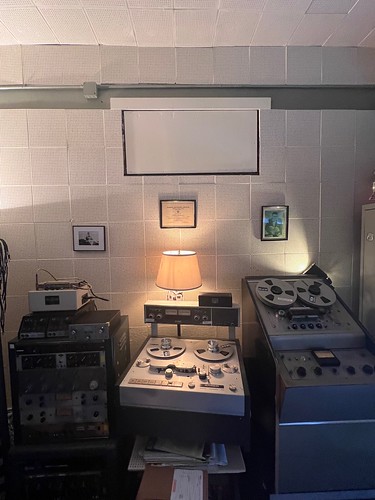content body

Halley Phillips and Jerry Phillips, the granddaughter and son of the Father of Rock ‘n’ Roll, Sam Phillips, hold an Alabama Polytechnic Institute certificate that Sam Phillips earned in 1943. The certificate represents a Fundamentals of Radio I course that helped launch Phillips' path to becoming the Father of Rock 'n' Roll and his discovering many great musicians, including Elvis Presley. Photo courtesy of Houston Cofield.
If not for a course offered 80 years ago by Auburn University — then Alabama Polytechnic Institute (API) — the fate of Rock ‘n’ Roll might have forever changed.
An aged and yellowed API document framed and displayed proudly on a wall inside the Sun Studio control room in Memphis, Tennessee, represents the completion of a critical Fundamentals of Radio I course that set a 20-year-old Sam Phillips on his path to becoming the “Father of Rock ‘n’ Roll.”
“I think it’s a heavier connection than anyone can realize,” said Jerry Phillips, Sam Phillips’ son, referring to the API course. “There might not have been a Sun Records or an Elvis Presley had he (Sam) not taken this course.”
At 8 1/2 by 11 inches, the document might seem small, but Sam Phillips’ family says the course it represents holds immense weight in music history, as the Father of Rock ‘n’ Roll might have followed a different path without the educational offering that API provided in 1943 as an extension course in his hometown of Florence, Alabama.
“It really upped his game, as far as his radio career goes,” said Halley Phillips, Sam Phillips’ granddaughter and vice president of Sam Phillips Recording Service, Big River Broadcasting Corporation and Hi-Lo Music Incorporated. “All of those things really do go hand-in-hand in his journey. Without that knowledge, I don’t know that that would have happened.”
“There might not have been a Sun Records or an Elvis Presley had he (Sam Phillips) not taken this course.”
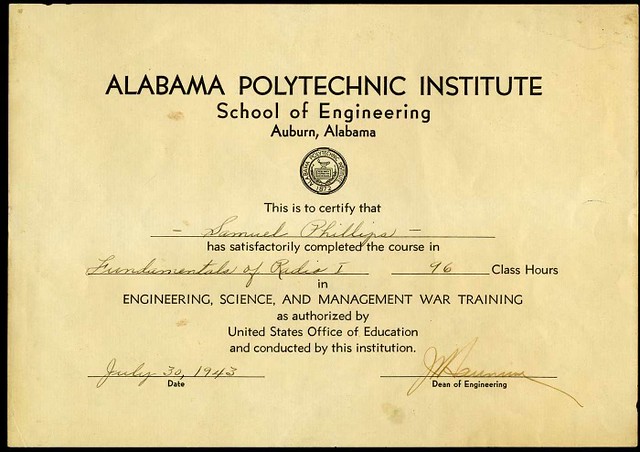
Pictured here is the certificate that Sam Phillips earned for his completion of a Fundamentals of Radio I course from API, known today as Auburn University. The certificate is displayed on the wall of the Sun Studio control room.

Sam Phillips is pictured with Elvis Presley inside the recording studio. To the left of Phillips' shoulder is the API certificate, representing the course that started it all for Phillips to become the Father of Rock 'n' Roll and discover Presley and so many other greats.
A sound foundation
It was on July 30, 1943, that Sam Phillips — who would later launch Sun Records and discover Presley, Johnny Cash, Jerry Lee Lewis and many other greats — received the API certificate that allowed him to gain his Class C certification to run a radio station. Today, Jerry Phillips calls his dad’s Auburn connection “ground zero” from where everything else branched.
“One of the most important things that happened to him in his life, in my opinion, was that course,” he said. “It was like building the foundation, like a solid foundation for whatever he was trying to do. He could always fall back on that knowledge.”
And while Jerry Phillips had heard of the certificate while growing up, he said it was a recent call from the university about the seminal course — spurred on by a sighting of the framed document in what is now known as Sun Studio — that caused him to further analyze its full significance.
“When Auburn brought it to my attention, it really came home to me that that may have been the start of almost everything,” he said.
The recognition of such an instrumental connection comes at a timely moment as the world celebrates the 100th anniversary of Sam Phillips’ birth this year. The centennial celebration includes a special exhibit at the Rock & Roll Hall of Fame in Cleveland.
“We’re really excited about that,” Halley Phillips said. “We've had a presence there for quite some time now, but there’s a little new life in that with this being the 100th year of celebrating Sam’s birth. It (the new exhibit) looks incredible. So, if people are anywhere near Cleveland, they should certainly check it out.”
Sam Phillips was among the first group to be inducted into the Rock & Roll Hall of Fame in 1986. On Nov. 3, a new class of rock greats will be added at the hall’s next induction ceremony at Barclays Center in Brooklyn, New York. Also on Nov. 3, Sun Record Company will celebrate the 100th anniversary with the launch of a two-LP anthology of songs Sam Phillips brought to life called “Where Rock ‘n’ Roll was born: 100 years of Sam Phillips.”
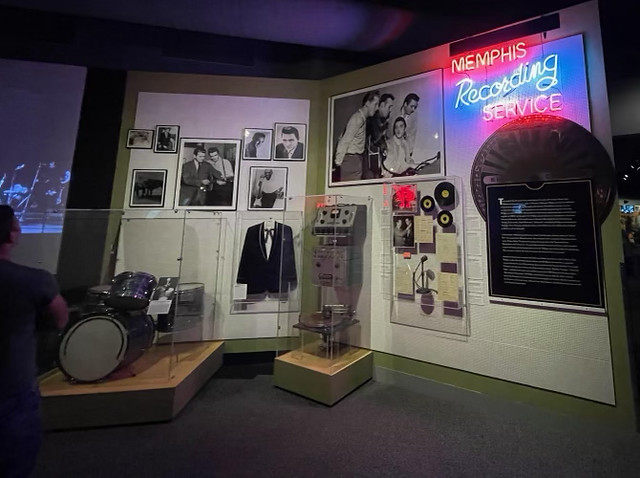
A new exhibit about Sam Phillips, the Father of Rock ‘n’ Roll, has launched in the Rock & Roll Hall of Fame in Cleveland in honor of the 100th anniversary of Phillips’ birth.

The original neon sign for the Memphis Recording Service is on display at Sun Studio in Memphis.
The fundamentals of rock
Long before accolades and the existence of “Rock ‘n’ Roll,” Sam Phillips lived in his hometown of Florence, Alabama, and in 1943 was the sole supporter of his widowed mother and deaf and mute aunt. It was a difficult time in his life, but he was doing his part to help his family following The Great Depression and the untimely death of his father in 1941. Amid those circumstances, he worked in a grocery store, a funeral parlor, a radio station as an announcer and also had the desire to become a criminal defense attorney to give voice to the underrepresented.
It was the Fundamentals of Radio I engineering course from API that taught him the necessary technical skills to ultimately pursue a career solely in radio.
“He was already interested in radio, but I just don't think he would have been that interested in the equipment part of it, the sound of everything (without the API course),” Jerry Phillips said. “And I just think it was a huge part of Rock ‘n’ Roll music.”
And it was helpful that he wouldn’t need to attend the course in Auburn since API was making the class available at other institutions throughout the state of Alabama — including one very close to Sam Phillips: Florence State Teachers College, which today is known as the University of North Alabama. The radio course was part of API’s desire to help the military train as many as possible in such trades that would prove helpful in the war and at home. It also was a strong part of the university’s land-grant mission of opening greater access to education throughout the state of Alabama — a mission that Auburn continues to advance to this day.
“Throughout its history, Auburn has played an integral role in advancing the state of Alabama and beyond through education that changes lives,” said Auburn President Christopher B. Roberts. “The story of Sam Phillips is a shining example of how Auburn’s outreach in the state has opened the door to so many opportunities through the years — in this case fueling ingenuity and innovation and setting the foundation for the future Father of Rock ‘n’ Roll.”
Sam Phillips earned his certificate after a total of 96 class hours. The document is displayed just inside the control room of Sun Studio to the right of the control room soundboard. When standing next to the framed certificate, one only needs to look down through a pane of viewing glass a few feet away to the recording room where B.B. King, Presley, Cash, Lewis and others — from Howlin’ Wolf to the Prisonaires to Roy Orbison to Carl Perkins, who wrote Blue Suede Shoes — were first discovered by Sam Phillips.
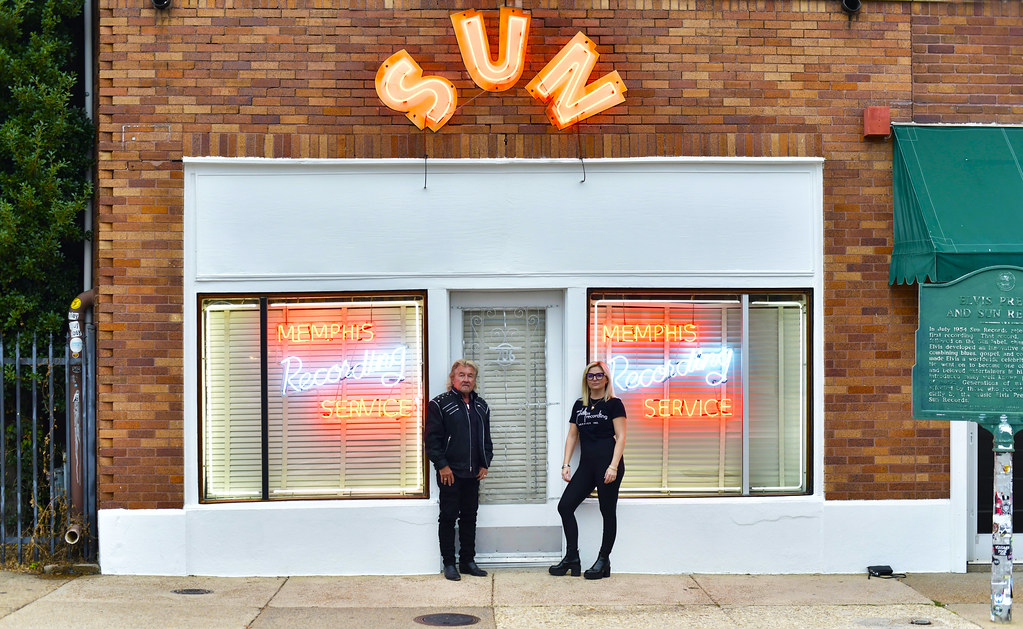
Jerry and Halley Phillips stand outside the entrance to the former Memphis Recording Service and Sun Records, where so many great musicians were recorded by Sam Phillips. Photo courtesy of Houston Cofield.
Tours are held daily inside Sun Studio, and crowds fill its recording room, which has remained preserved since the 1950s and offers visitors a look at everything from the original microphone Presley used to a darkened ivory key where Lewis extinguished his cigar while fervently playing piano. Historic photos of past performances there adorn the recording studio’s walls, and a faint vintage scent from the building’s past as an auto repair shop, mixed with polished mic metal and aged acoustic tiles, remains.
Without Sam Phillips taking that course from Auburn, though, would any of it have happened? The book, “The Man Who Invented Rock ‘n’ Roll,” written by music historian Peter Guralnick, vouches for the importance of the Auburn course.
“With an eye to furthering his career, he (Sam Phillips) took an Alabama Polytechnic Institute (later to be known as Auburn University) extension course offered at Florence State,” according to the book. “It was given five nights a week, three hours a night, for six weeks and was aimed primarily at certifying electrical engineers for the war effort, but it would permit him to get his Class C permit, something he needed in order to be able to engineer as well as announce his own programs.”
The book adds that “he (Sam Phillips) peppered the instructor, John Smith, the chief engineer at (radio station) WLAY, with questions until he just about wore him out.”
Equipped with that certification and resulting radio engineering experience, Sam Phillips ultimately made his way to Memphis, where he worked in radio at the famed Peabody Hotel before opening the Memphis Recording Service, which became the studio for his own label, Sun Records — a name that his son, Jerry, said was based on his father’s mantra of hope: “Every day is a brand new day.”
Giving a voice to all
Central to his starting a studio was his determination to give a voice and value to all races, classes and genders. It was his work at Sun Records that spurred on a cultural revolution, helping bridge the racial divide of the times by welcoming musicians who weren’t getting needed exposure. Sam Phillips’ slogan was, “We record anything, anywhere, anytime,” and he had a gift for finding a unique and raw sound that was different from the mainstream music typically played on radio stations of the time. His family said he was focused on changing lives and breaking down barriers along the way through music.
“My dad always felt like he was helping people out with their life to make a better life for themselves,” Jerry Phillips said.
Armed with technical skill, engineering prowess and a keen ear for what the human voice could create from the depths of hard experience, he wanted his recordings to capture the authenticity of life and the true human spirit — a “perfect imperfection,” as he put it, and the deep-down emotions we all share. Sam Phillips — whom legendary Rolling Stones guitarist Keith Richards referred to as a “genius” — also was known for his natural talent of pulling out the best in a person, shaping artists with his suggestions and building their confidence while insisting they give all they could in their performance.
A key moment in history occurred in 1951 when Sam Phillips recorded a track often cited as the first Rock ‘n’ Roll song, “Rocket 88,” performed by Jackie Brenston and his Delta Cats and distinct for its prominent and novel use of a distorted guitar — a sound that resulted from a broken amplifier. Decades later, an essay submitted as part of his Rock & Roll Hall of Fame induction noted how Sam Phillips “not only recorded the varied streams of ethnic music throughout the South, from blues to country, but was convinced he could bring them together in one irresistible pop package.”
And that’s just what happened after a baby-faced Presley first walked through the doors of Sun Records in July 1953. Presley visited the studio to record two songs — reportedly as a birthday gift for his mother and likely to also catch the attention of Sam Phillips. Presley returned to Sun Records many more times and, through the skilled guidance and hard promotional work of Sam Phillips, launched his own journey in becoming the King of Rock ‘n’ Roll, thereby immensely growing the popularity of the new music genre. Jerry Phillips said his father and the King of Rock ‘n’ Roll remained great friends through the years and would often hang out at the Phillips home and studio.
Many performers through the years, he said, would often ask, “Sam, how do you make us sound so good?” The son of the Father of Rock ‘n’ Roll said he believes it all goes back to what his dad learned through the API course.
Records from the past
Archives in Auburn’s Ralph Brown Draughon Library detail the API course that started it all. The year was 1943, and API was doing its part to support the nation’s war effort amid World War II. The university offered many classes on campus and throughout the state that were focused on important trades, including that of radio work.
The class Sam Phillips took taught him about everything from soldering to schematic circuits to wire size and resistivity, as well as Ohm’s Law and color codes for resistors and capacitors. He also learned about the comparison of sound waves to radio waves, the properties of antennas, signal flow and how to use a cathode ray oscilloscope — a lab instrument that provides accurate time and amplitude measurements of voltage signals over a wide range of frequencies.
Auburn archives listed many fields of training at the time, including that of aeronautical, automotive, chemical, electrical and radio engineers. Mechanics for air-conditioning and refrigerating also were trained, as were chemists, mathematicians, meteorologists and physicists.
“We have trained and retrained more than 10,000 engineers for special work at industrial centers such as Birmingham, Montgomery, Mobile, Gadsden, Anniston and Huntsville,” wrote then API President L.N. Duncan in a letter dated Nov. 3, 1942, to Senate Majority Whip Lister Hill.
Lt. Col. Black R. Van Leer of the Army Specialized Training Division wrote back to Duncan, stating, “Colonel Beukema asked me to extend to you and your staff of Alabama Polytechnic Institute his congratulations upon the many and varied contributions which your institution is making to the war effort. Alabama Polytechnic Institute has cooperated with the Army in its training program for many years, and we are looking to a continuation of this pleasant relationship.”

Halley Phillips is pictured at a recent Auburn baseball game with her youngest son, Noah.
A War Eagle family
Halley Philips said her grandfather’s pivotal connection to the API course so long ago is central to her being a big Auburn fan.
“The connection with my grandfather, Sam Phillips, and Alabama Polytechnic Institute — that was my first reason to love Auburn University,” she said, adding that she also has a cousin who graduated from Auburn and became a veterinarian.
“As a teenager, I would go down and visit him because I actually thought I might be a veterinarian,” she said, noting that many of her cousin’s family became Auburn graduates as well. “So, it’s a big Auburn household for us. War Eagle!”
She said the family’s ties to the state of Alabama likewise remain strong.
“My grandfather was born in Florence, Alabama, and moved to Memphis,” she said. “I was born in Memphis and moved to Florence, Alabama. And I still work for our family radio stations that he started there in 1973 after he found success in the music business. And I’m involved with our recording studio here in Memphis. So, there are still giant ties between Memphis and Alabama.”
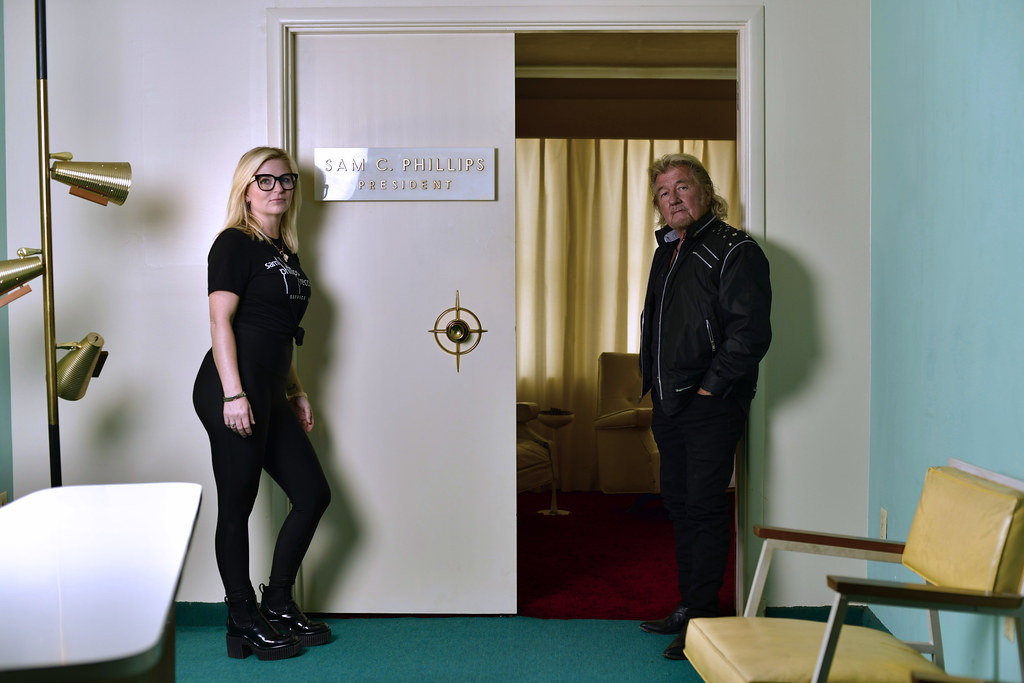
Halley and Jerry Phillips stand at the door of Sam Phillips' office, which has remained unchanged since the 1960s. Photo courtesy of Houston Cofield.
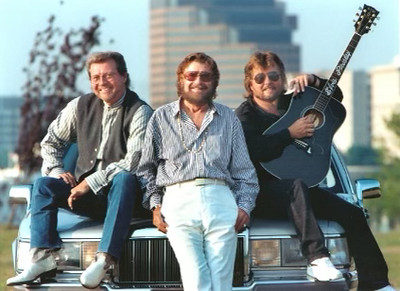
Sam Phillips (center) is pictured with his sons, Knox (left) and Jerry.
A Sun-filled future
The legacy of all that Sam Phillips accomplished is advancing today through the Sam Phillips Recording Studio — which he founded in 1960 just blocks away from Sun Studio. The Phillips Studio — with its green and white exterior — has its own iconic history, with recordings there by Roy Orbison, Bob Dylan, Johnny Cash, Phil Collins, Hank Williams Jr. and Kid Rock, among others. Sam Phillips’ office in the studio remains intact as it was during the 1960s. The studio continues today under the leadership of his son and granddaughter.
“I feel like I’m doing my best to continue the legacy of my grandfather by carrying the independent spirit, still creating music,” Halley Phillips said. “And I’m working alongside my father and producing music, but also keeping our radio station businesses going and our publishing companies. So, it’s kind of like God’s gift to my heart a little bit that I get to do this and continue this legacy that he started.”
There’s also Memphis music veteran Scott Bomar, the Emmy-winning and Grammy-nominated producer, engineer and musician who is the chief engineer at Phillips Recording. Earlier this year, Sam Phillips Recording partnered with the Stax Museum of American Soul Music to bring to the Phillips studio the original Spectra Sonics 1020 recording console that had been used in Stax Records’ Studio B in the 1960s and 1970s. Bomar was instrumental in fully restoring the console.
“So, there’s a really cool cross-section of music history now in Memphis, and people are really excited to get to come and create in this space and through that console,” Halley Phillips said.
Jerry Phillips is also quick to note the immense contributions of his brother, Knox Phillips, to the longevity of the Phillips studio.
“He was really the torch bearer,” he said of his brother, who died in 2020. “My brother picked the torch up of continuing to educate people about what our father had done.”
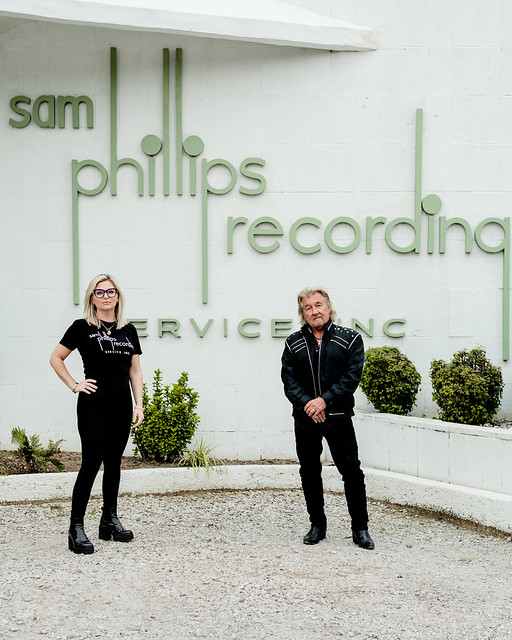
Halley and Jerry Phillips are pictured standing in front of the Sam Phillips Recording Service in Memphis. Photo courtesy Houston Cofield.
These days, no tours are offered at the Sam Phillips Recording Studio. The site keeps busy with its analog-focused recordings, having several big and up-and-coming acts visit frequently.
“So, we have a very independent spirit,” Jerry Phillips said. “We’re looking for people that have independent music, new original ideas, new original sounds, but also harken back to the roots of music.”
Ultimately, Halley Phillips said it’s all about furthering the legacy of her grandfather and continuing to fan the flame that was lit so long ago in an API class that forever changed the world.
“I hope that future generations understand the value of human worth that he instilled in me and my family that we still try to carry forward,” Halley Phillips said. “With this banner year being Sam’s 100th birthday, I hope people take the time to reflect on his life, to learn about all of the people that he helped along the way and all of the incredible music that he created. And if they’re interested in creating music, know that our family is still carrying the torch for Sam.”






